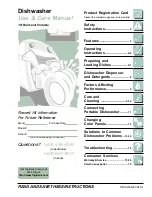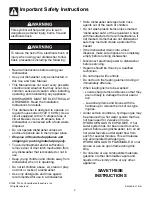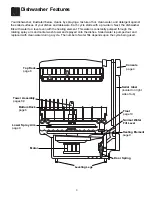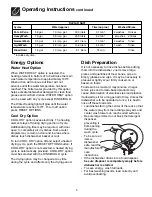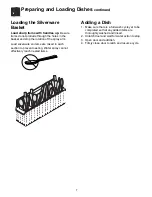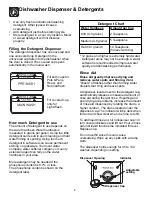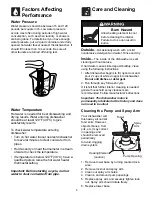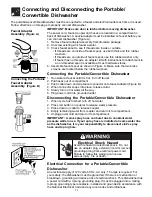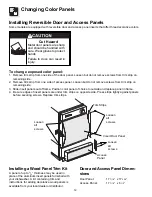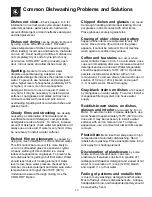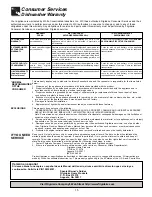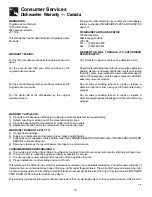
5
Water Heat Option
When WATER HEAT option is selected, the
heating element in bottom of tub will raise the main
wash water temperature to approximately 140°F.
Wash action will continue but timer will not
advance until this water temperature has been
reached. The hotter water provided by this option
helps activate dishwasher detergent to clean food
grease and soil from dishes. WATER HEAT option
can be used with any cycle except RINSE/HOLD.
The Water Heating light will glow until the water
temperature reaches 140°F. To turn off option
press RESET OPTIONS.
Cool Dry Option
COOL DRY option saves electricity. The heating
element stays off during drying portion of cycle.
Additional drying time may be required, with door
open, to completely air dry dishes. Some water
droplets may remain on door and in areas where
dishes touch dishwasher basket or rack.
To turn COOL DRY option off and select a heated
drying cycle, push the RESET OPTIONS button. If
COOL DRY option is not selected, a heated drying
cycle is automatically provided. COOL DRY option
must be selected with the RINSE/HOLD cycle.
The drying option may be changed at any time
during the cycle and affects only the drying period.
Operating Instructions
continued
Energy Options
* Includes dry time.
Cycle Chart
Cycles
Water (approx.)
Time (approx.)
Washes/Rinses
Pots & Pans
2 washes
3 rinses
8.8 gal.
33.3 liters
7.3 imp. gal.
91 min.*
Heavy Wash
82 min.*
2 washes
2 rinses
7.0 gal.
26.5 liters
5.8 imp. gal.
Normal Wash
73 min.*
2 washes
1 rinse
5.3 gal.
20.1 liters
4.4 imp. gal.
Light Wash
64 min.*
1 wash
1 rinse
2.9 imp. gal.
3.5 gal.
13.2 liters
Rinse/Hold
14 min.
1 rinse
1.3 imp. gal.
6.1 liters
1.6 gal.
Dish Preparation
It is not necessary to rinse dishes before putting
them into the dishwasher. Just remove large
pieces and quantities of food, bones, pits, etc.
Empty glasses and cups. It may be necessary to
presoak or lightly scour firmly cooked-on or
baked-on foods.
Foods such as mustard, mayonnaise, vinegar,
lemon juice and tomato-based products may
cause discoloration of stainless steel and plastics
if allowed to sit for a long period of time. Unless the
dishwasher is to be operated at once, it is best to
rinse off these food soils.
• Load dishes facing the center of the rack so that
the water spray from the rotating spray arm and
center wash tower can reach soiled surfaces.
• Be sure large items do not block the detergent
dispenser,
preventing it
from opening
during the
wash cycle.
• To be sure an
item is
dishwasher
safe, read the
manufacturer’s
care
instructions.
• If the dishwasher drains into a food disposer,
be sure disposer is completely empty before
dishwasher is started.
• To save energy, wash full loads.
• For best washing results, load correctly and
avoid overloading.

